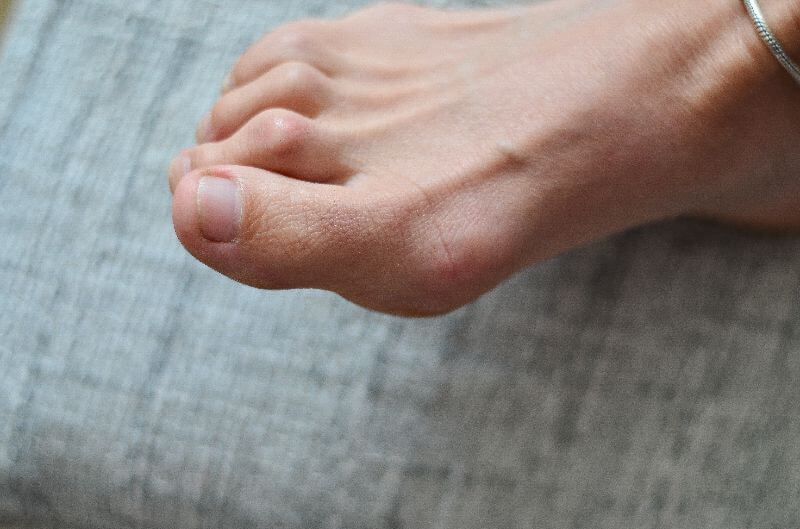Hammertoe is an abnormal bend in the joints of one or more of your toes The condition usually starts as a mild deformity and gets progressively worse over time. When toes get bent this way, it puts undue pressure on them while wearing shoes, causing problems to develop.
In the early stages, the hammertoe is flexible and symptoms can be managed with noninvasive measures or minimally invasive in-office surgical procedures. But if left untreated, a hammertoe can become more rigid and will need surgical treatment.
Hammertoe is usually caused by an imbalance in the muscle/tendon around the toe joint. This causes the toe’s middle joint to buckle, and it becomes stuck in that position. Over time, this imbalance results in mechanical changes in the foot, leading to bending of the toes.
A hammertoe may be further aggravated by shoes that don’t fit properly. A hammertoe may form if a toe is too long and is forced into a cramped position inside a tight shoe.
Occasionally, a hammertoe results from an earlier trauma to the toe. For some people, a hammertoe is inherited.
Common symptoms of a hammertoe include:
- Pain or irritation of the affected toe when wearing shoes
- Corns and calluses (a buildup of skin) on the toe, between two toes, or on the ball of the foot.
- Inflammation, redness, or a burning sensation
- Bending (contracture) of the toe
- Open sores (these may be seen in severe cases)
A hammertoe is usually quite visually apparent. However, to confirm no other underlying conditions that might need priority treatment, Dr. Braaton will confirm the diagnosis after a thorough examination of your foot. He will also ask for a history of your symptoms. During your physical examination, he may attempt to reproduce your symptoms by manipulating your foot and studying how your toes bend.
X-rays may also be ordered to determine the degree of the deformity and assess any structural changes that may have affected the bones in your foot.
If you are diagnosed with hammertoe, Dr. Braaton will develop an individualized treatment plan suited to your needs.
Hammertoe is a progressive condition that doesn’t go away on its own, and patients should receive early medical attention. Hammertoe never improves without medical intervention.
There are various treatment options available for hammertoe. Dr. Braaton will recommend the best treatment option for you based on the severity of your hammertoe.
Several nonsurgical treatment options can be undertaken, including:
Padding corns and calluses. Dr. Braaton can provide or prescribe pads designed to shield corns from irritation. If you want to try over-the-counter pads, avoid the medicated types as they may contain a small amount of acid that can be harmful. Consult Dr. Braaton about this option.
Changes in shoewear. Patients should avoid wearing certain types of shoes, such as
- Shoes with pointed toes
- Shoes that are too short
- Shoes with high heels
These types of shoes tend to force your toe against the front of the shoe and aggravate your condition. Instead, choose comfortable shoes with:
- A deep, roomy toe box
- Heels no higher than 1.5 inches
- At least one-half inch of space between your longest toe (the big toe or second toe) and the tip of the shoe
Orthotic devices. A custom orthotic device placed in your shoe may help control the muscle/tendon imbalance and stop the hammertoe from getting worse. Orthotics also help to reduce pain.
Medications. Oral non-steroidal anti-inflammatory drugs (NSAIDs), such as ibuprofen, may be recommended to reduce pain and inflammation.
Splinting/strapping. Dr. Braaton may apply splints or small straps to realign the bent toe.
If the toe is still flexible and is not stuck in position, Dr. Braaton may perform minimally invasive surgical procedures in-office to address a hammertoe. However, in cases where the hammertoe has become more rigid and painful or when an open sore has developed, open surgery is needed.
In selecting the procedure or combination of procedures for your particular case, Dr. Braaton will consider the extent of the deformity in the foot, the number of toes involved, your age, and your activity level.
Patients with hammertoe will most often also have bunions or other foot deformities that can be corrected at the same time. The recovery period will vary depending on the type and number of procedure(s) performed.
You can prevent foot problems, such as hammertoe, by wearing the right shoes, and taking care of your feet.
Having good circulation is essential for healthy feet. Take breaks to stretch if you’ve been sitting for a prolonged period. Additionally, when you are sitting down, put your feet up. Foot massages and a warm foot bath are also good ways to take care of your feet.
People with diabetes should take special care to check their feet daily for foot problems. This is because diabetes can cause poor circulation or numbness in your toes.
At OrthoMed Center, our orthopedic foot and ankle surgeons offer a full range of nonsurgical and surgical treatment options for hammertoe relief. If you would like to schedule an appointment, please call
(209) 524-4438, or you may
request an appointment online.



